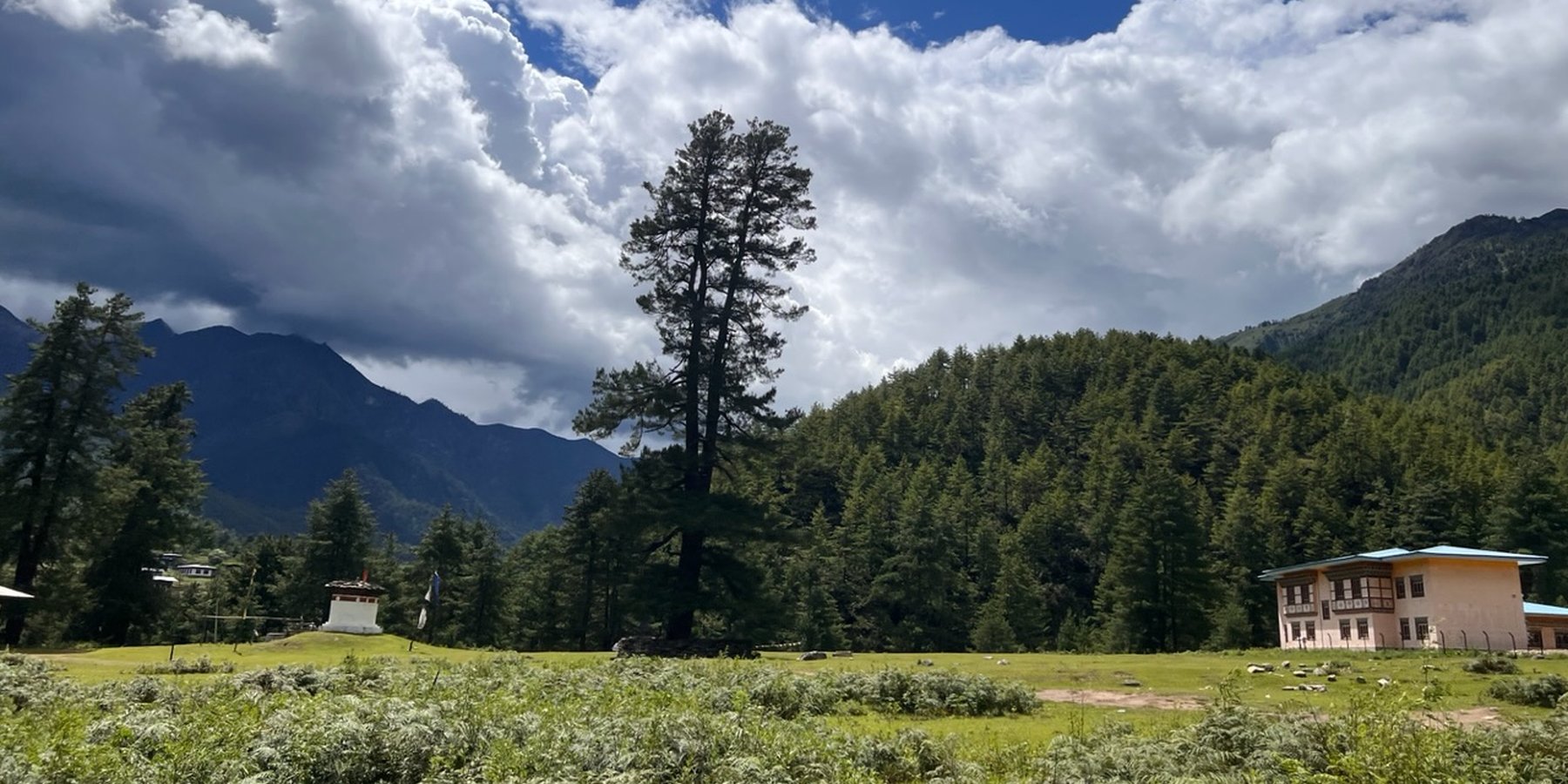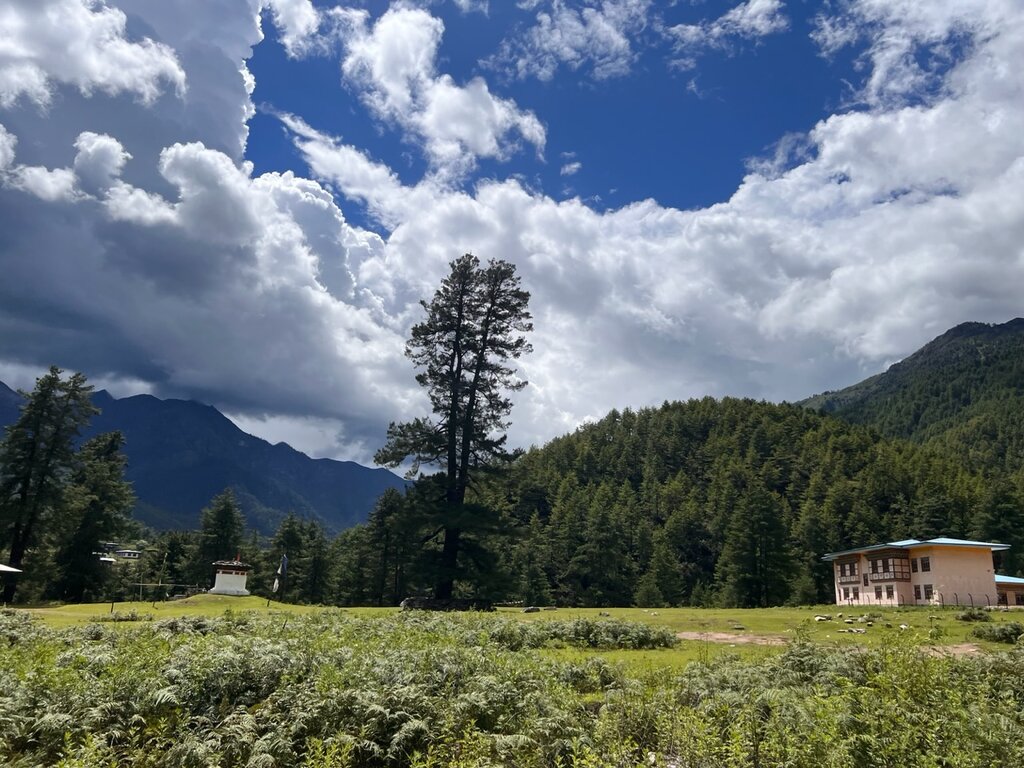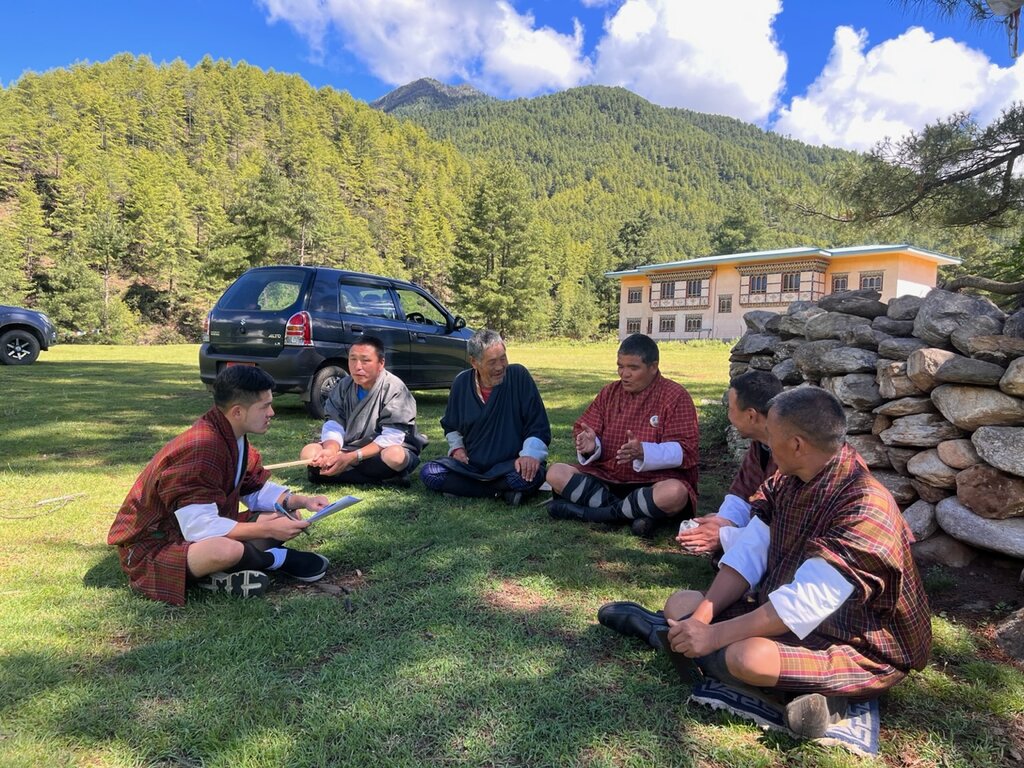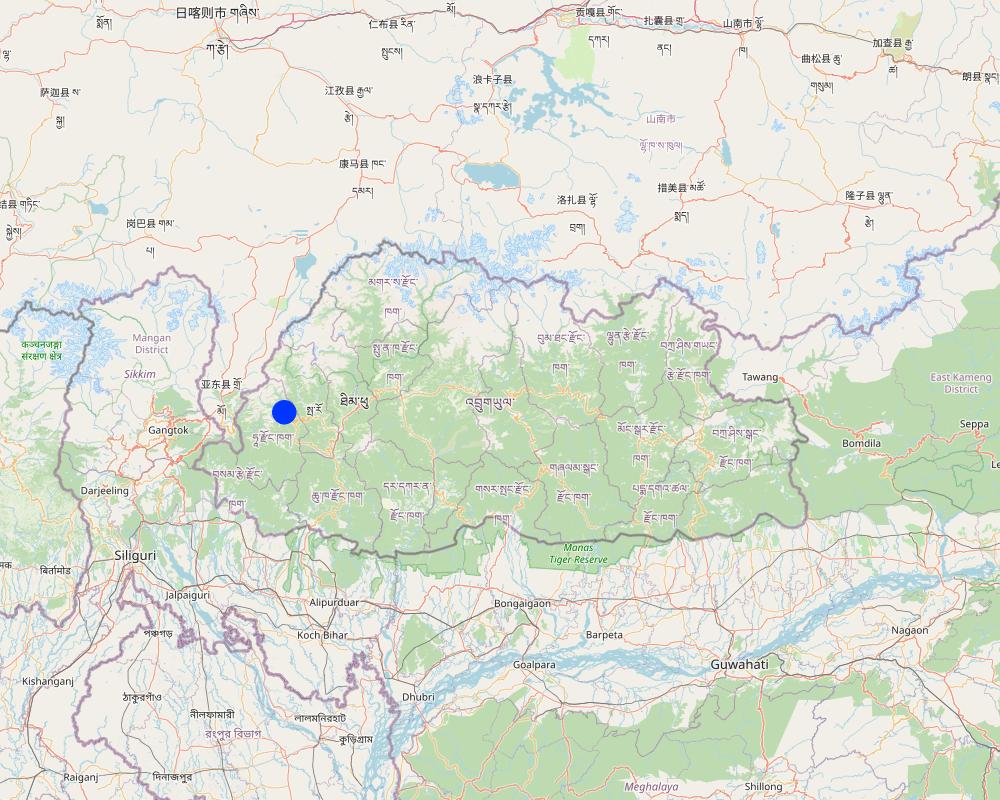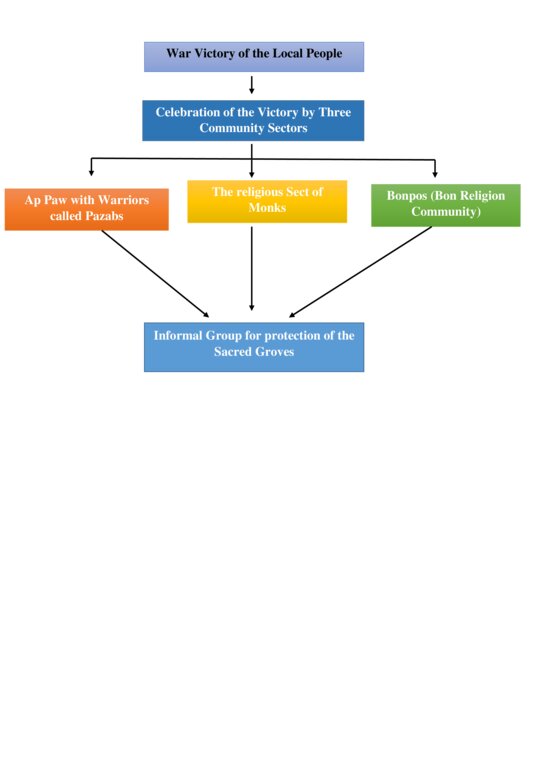Sacred Groves as Informal Protected Areas [不丹]
- 创建:
- 更新:
- 编制者: Karma Wangdi
- 编辑者: Tashi Wangdi
- 审查者: William Critchley, Rima Mekdaschi Studer
Ney dang Draktsen Tshu Sakhong Sungchop Khey Chhey Yoep (གནས་དང་བྲག་བཙན་ཚུ་ས་ཁོངས་སྲུང་སྐྱོབ་ཁྱད་ཆོད་ཡོདཔ།)
approaches_6856 - 不丹
查看章节
全部展开 全部收起1. 一般信息
1.2 参与方法评估和文件编制的资源人员和机构的联系方式
关键资源人员
土地使用者:
Penjor Tashi
+97577370208
penjortashi73@gmail.com
Land user
Talung Chhiwog. Bji Geog Haa Dzongkhag
不丹
土地使用者:
Kachey Kachey
+97517653226 / +97577212528
Land user
Talung Chhiwog Bji Geog Haa Dzongkhag
不丹
土地使用者:
Passang Passang
+97517740196
Land user
Talung Chhiwog Bji Geog Haa Dzongkhag
不丹
土地使用者:
Norbu Kezang
+97517444777
Land user
Yangthang Chhiwog Bji Geog Haa Dzongkhag
不丹
土地使用者:
Tshentse Tshentse
+97517842997
Land user
Yangthang Chhiwog Bji Geog Haa Dzongkhag
不丹
有助于对方法进行记录/评估的机构名称(如相关)
National Soil Services Center, Department of Agric (National Soil Services Center, Department of Agric) - 不丹1.3 关于使用通过WOCAT记录的数据的条件
(现场)数据是什么时候汇编的?:
15/07/2023
编制者和关键资源人员接受有关使用通过WOCAT记录数据的条件。:
是
2. SLM方法的描述
2.1 该方法的简要说明
A sacred grove is considered to be the home of the Local Deity of a region and is revered and protected by the people with respect and dedication. Here, a sacred grove of trees and undisturbed ground surround a majestic blue pine that is believed to be more than 350 years old.
2.2 该方法的详细说明
该方法的详细说明:
A sacred grove is considered to be the home of the Local Deity of a region and is revered and protected by the people with respect and dedication. Here, a sacred grove of trees and undisturbed ground surround a majestic blue pine that is believed to be more than 350 years old.
The distinct feature of the approach is that it is undertaken by an informal group borne out of pure faith and dedication to their local hero and legend. In this case, people protect and conserve a particular sanctuary the size of two football pitches. Trees surround it with important signs and symptoms considered to serve the purpose of sacred offerings to the deity that saved the people of that locality in the 17th century AD.
In the middle is a tall blue pine tree that holds a prayer flag on its crown which is renewed once a year. It is believed to have been planted some 350 years ago to mark the victory of the people of Haa against Tibetan invaders. The victory of the Haaps was guaranteed by the magic and Herculaneum feat of Ap Chhundue who is said to have defeated every Tibetan soldier with a single slash in that very ground.
To revere him for his extraordinary deeds, people celebrate two types of occasions, decorating the surrounding trees and encircling the middle tree singing and citing words of praise to Ap Chhundue while holding a sword in one hand and a circular shield in another. The village's Pawo (oracle) performs his rituals, foretells the general predictions and warnings (if any) for the coming year, and suggests remedies and tips for a fruitful year ahead.
During the occasion, the trees that grow around are tied with colourful prayer flags and scarves. Different shapes and sizes of ritual cakes are made and kept in front of the sacred tree and a set of prayers is conducted by the monks led by the head lama of Haa Rabdey (monastic school). The sacred tree in the middle and other trees are included among the ritual cakes and have to be equally mentioned in the prayers that the monks recite. That is why these trees are left untouched.
As per the grandson of their former Ap Pawo (Astrologer/ Oracle) who never missed the events happening in that haven, he saw a connection and coexistence of three different backgrounds with one goal in mind, which was to preserve that sacred place and continue to pass it on to future generations.
In conclusion, the people of Haa not only preserve their culture and identity, but also preserve and promote the natural environment. No wonder Haa Dzongkhag (State) is still under 80% forest cover - contributing to a carbon-negative nation.
2.3 该方法的照片
关于照片的一般说明:
The photo was taken during the documentation in the middle of the ground surrounded by sacred groves.
2.4 该方法的视频
注释、简短说明:
n/a
2.5 采用该方法的国家/地区/地点
国家:
不丹
区域/州/省:
Haa
有关地点的进一步说明:
Jangkakha, Bji Geog
注释:
Exact spot where the sacred groves are is spotted and marked. The one we have documented is the most popular one in our country for which we can get data and the right information.
Map
×2.6 该方法的开始和终止日期
若不知道准确的年份,请注明该方法的大致开始日期。:
50多年前(传统)
注释:
Indeed more that 350 years has passed after the initiative.
2.7 方法的类型
- 传统/本土
2.8 该方法的主要目的/目标
The main aims/objectives of the approach are:
1) Maintaining the sanctity and sacredness of the place.
2) Protect sacred trees believed to hold important historical imprints.
3) Promote and preserve cultural and historical significance of the place through worship of the sacred trees and rocks in the place.
4) Strengthen and improve coordination and cooperation among different villages of the region.
2.9 推动或妨碍实施本办法所适用的技术的条件
社会/文化/宗教规范和价值观
- 启动
Preserves the social cohesion and traditional values of Haa valley.
- 阻碍
Difficult to organize due to the dwindling rural population.
财务资源和服务的可用性/可得性
- 启动
The local people celebrate two significant religions ceremonies in that place.
参与者的的协作/协调
- 启动
During religious ceremonies and offerings, people of different villages of the region come together to celebrate and worship the same hero (Guardian Deity)
3. 相关利益相关者的参与和角色
3.1 该方法涉及的利益相关者及其职责
- 当地土地使用者/当地社区
Indeed every people of the locality are involved especially the village representatives called Gup( Sub-district head) and other local leaders of different communities.
Their role is to protect the place from external destruction by foreign investors and wood industries.
- 社区组织
Lead by the community representatives, they honor and even celebrate and worship the trees in and around the celebration ground.
- 教师/学龄儿童/学生
Teachers lead students in bush cleaning and mass paper picking every 3 months and after big celebrations.
- 地方政府
Local government plays crucial role in organizing two important occasions where people of the community come together to celebrate and worship these sacred groves of trees.
3.2 当地土地使用者/当地社区参与该方法的不同阶段
| 当地土地使用者/当地社区的参与 | 指定参与人员并描述活动 | |
|---|---|---|
| 启动/动机 | 自我动员 | It all started in the 17th Century after local people decided to make offer and worship the sacred battle ground. |
| 计划 | 自我动员 | No other people or policy makers were involved in planning. |
| 实施 | The local people implemented this approach of protection and preservation of the natural environment | |
| 监测/评估 | 无 | |
| 无 |
3.3 流程图(如可用)
3.4 有关SLM技术选择的决策
具体说明谁有权决定选择要实施的技术:
- 仅限土地使用者(自主)
解释:
The approach is a non-formal self initiated cultural practice that is being passed down from forefathers to younger generation.
明确做出决策的依据:
- 个人经验和意见(无记录)
4. 技术支持、能力建设和知识管理
4.1 能力建设/培训
是否为土地使用者/其他利益相关者提供培训?:
否
4.2 咨询服务
土地使用者有权使用咨询服务吗?:
否
4.3 机构强化(组织发展)
是否通过这种方法建立或加强了机构?:
- 是,少许
具体说明机构的强化或建立程度:
- 区域
说明机构、角色和职责、成员等。:
This approach brings together different sectors of Haa Dzongkhag to celebrate amd honour the local deity of Haa on the ground where sacred groves of forest is protected.
4.4 监测和评估
监测和评估是该方法的一部分吗?:
否
4.5 研究
研究是该方法的一部分吗?
否
5. 融资和外部物质支持
5.1 该方法中SLM组成部分的年度预算
如果不知道准确的年度预算,请给出一个范围:
- < 2,000
注释(例如主要的资助来源/主要捐助者):
The main donor for the preservation of culture to conserve the Nature through protecting the area is Culture sector of the Dzongkhag Administration.
5.2 为土地使用者提供财政/物质支援
土地使用者是否获得实施该技术的财政/物质支持?:
否
5.3 对特定投入的补贴(包括劳动力)
- 无
如果土地使用者的劳动力是一项重要的投入,那么是不是:
- 自愿
5.4 信用
是否根据SLM活动的方法给予信用值?:
否
5.5 其它激励或手段
是否有其他激励措施或工具用于促进SLM技术的实施?:
否
6. 影响分析和结论性陈述
6.1 方法的影响
Indeed the approach is a consistent cooperative commitment of the lo at land users.
这种方法是否有助于基于证据的决策?:
- 否
- 是,很少
- 是,中等
- 是,支持力度很大
Yes, there are incidences of people going against the belief and rule of the approach that they faced consequences in the form of mishaps and trouble.
该方法是否帮助土地使用者实施和维护SLM技术?:
- 否
- 是,很少
- 是,中等
- 是,支持力度很大
This approach directly leads to natural preservation and promotion of Sustainable Land Management.
该方法是否建立/加强了机构、利益相关者之间的合作?:
- 否
- 是,很少
- 是,中等
- 是,支持力度很大
This approach leads to strengthening of the collaboration and cooperation among communities especially during one of the celebrations of their local deity where trees are also worshiped and appreciated.
该方法是否缓解了冲突?:
- 否
- 是,很少
- 是,中等
- 是,支持力度很大
There’s no direct climate mitigation but in a way fights global warming through prevention of deforestation.
该方法是否带来了更可持续的能源使用?:
- 否
- 是,很少
- 是,中等
- 是,支持力度很大
The idea of the approach is that people can collect dead and dry branches of wood from the sacred groves. The land users could also collect dry pine leaves but should not cut down the trees or surrounding young pants. So definitely the approach encourages sustainable use of resources.
该方法是否提高了土地使用者适应气候变化/极端情况和减轻气候相关灾害的能力?:
- 否
- 是,很少
- 是,中等
- 是,支持力度很大
该方法是否会带来就业、收入机会?:
- 否
- 是,很少
- 是,中等
- 是,支持力度很大
It is an informal group/ approach where no one is recruited.
6.2 土地使用者实施SLM的主要动机
- 增加生产
- 减少土地退化
Proper growth and establishment of the natural habitat definitely reduced land degradation.
- 降低灾害风险
Disaster such as soil erosions are reduced.
- 声望、社会压力/社会凝聚
Social cohesion and cooperation promoted
- 习俗和信仰,道德
This approach entirely rests upon customs and beliefs.
6.3 方法活动的可持续性
土地使用者能否维持通过该方法实施的措施(无外部支持的情况下)?:
- 是
若是,请说明如何维持:
This approach of protected area has been passed down for generations dating back to 17th century and with strong and undying belief, it will sustain without external support.
6.4 该方法的长处/优点
| 土地使用者眼中的长处/优势/机会 |
|---|
| Preservation and promotion of culture and traditions |
| Paying tribute and respects, which ultimately leads to blessings and protection ensured by their local deity. |
| Prevention of uncontrollable calamities and disasters. |
| 编制者或其他关键资源人员认为的长处/优势/机会 |
|---|
| Improvement of unity and cooperation among and within local communities. |
| Unique culture and custom which provides unique identity to the local people. |
| Intense respect, connection and harmony with nature and unseen forces. |
6.5 该方法的弱点/缺点以及克服它们的方法
| 土地使用者认为的弱点/缺点/风险 | 如何克服它们? |
|---|---|
| Lack of belief and interest in such beliefs by younger generation. | Parents must retell the legendary history and restore faith in young minds. |
| Diminishing of the faith and customs passed down from forefathers. | Spark faith and interest through stories and proofs. |
| Lack of cooperation among and within local communities. | Must make it a formal group in future. |
| 编制者或其他关键资源人员认为的弱点/缺点/风险 | 如何克服它们? |
|---|---|
| Lack of written accounts and documents. | Must start drafting general charter of the informal group. |
| Lack of proper hierarchy and coordination of events related to the approach. | Must have a formal association. |
| Lack of funds and budget for general coordination and celebrations during the workshop of the sacred grooves. | Provide funds for continued preservation of the natural habitat of the place. |
7. 参考和链接
7.1 方法/信息来源
- 实地考察、实地调查
5 informants
- 与土地使用者的访谈
5 people were interviewed.
7.2 参考可用出版物
标题、作者、年份、ISBN:
n/a
可以从哪里获得?成本如何?
n/a
7.3 链接到网络上可用的相关信息
标题/说明:
n/a
URL:
n/a
链接和模块
全部展开 全部收起链接
无链接
模块
无模块


